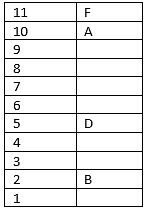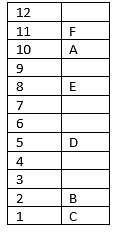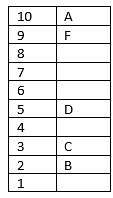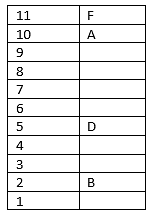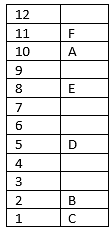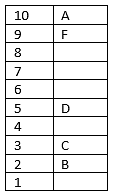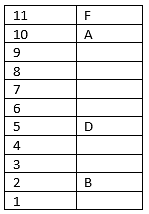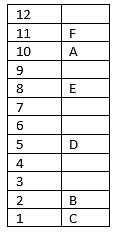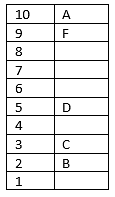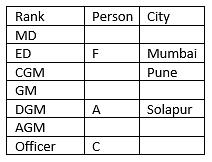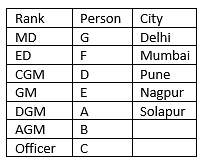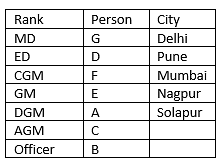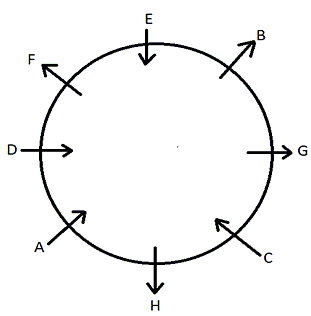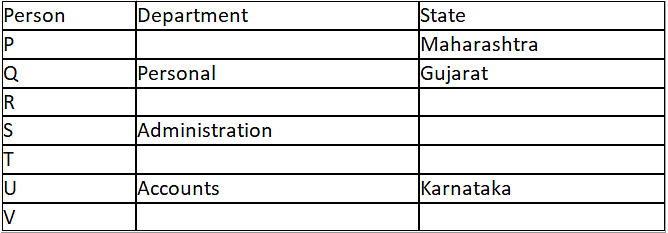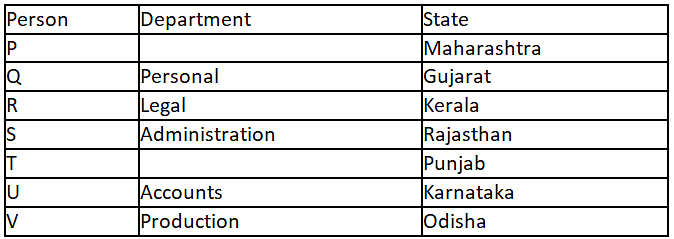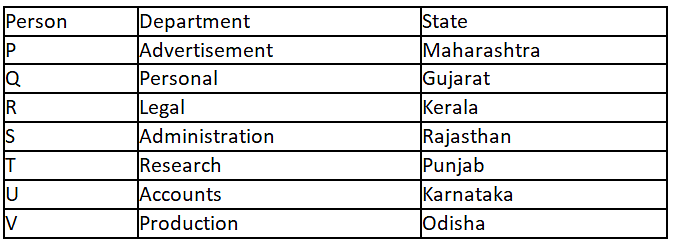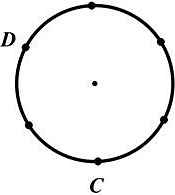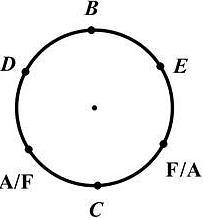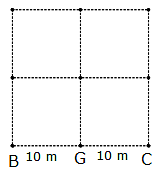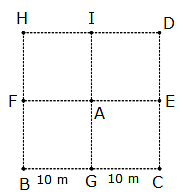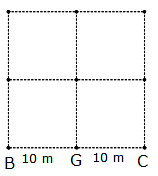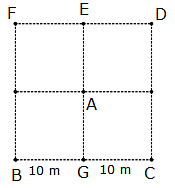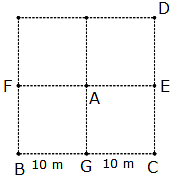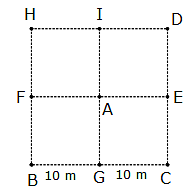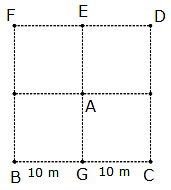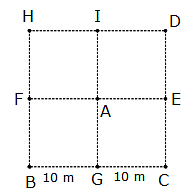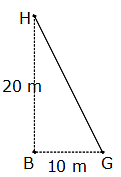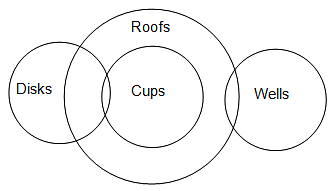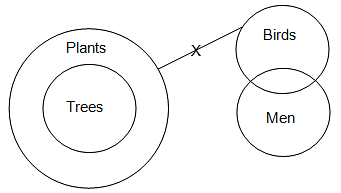IBPS SO Prelims Mock Test - 2 - Bank Exams MCQ
30 Questions MCQ Test IBPS SO Mock Test Series & Past Year Papers 2024 - IBPS SO Prelims Mock Test - 2
Directions: In this question, a statement followed by two assumptions numbered I and II is given. An assumption is something supposed or taken for granted. You have to consider the statement and the assumptions and decide which of the assumptions is/are implicit in the statement.
Statement:
"We need to appoint more teachers." — Principal informs the school staff
Assumptions:
I. Teachers are available.
II. Present teachers are not good.
Directions: Certain number of people were living in an apartment with a certain number of floors such that only one person was living in each floor. The names of only few persons was known. There were not more than 13 floors. The names of not more than 2 persons living consecutively was known. The number of people living above D was more than the number of people living below. E who was living in an even numbered floor was living above B. A was living in a floor immediately below F. 7 people were living between A and B. B was at 2nd floor and adjacent to C. E was not adjacent to D who was at an odd numbered floor. There were at least two people living between C and D. F was neither on the top nor on the third floor from the top.
Q. How many people lived above D?
| 1 Crore+ students have signed up on EduRev. Have you? Download the App |
Directions: Certain number of people were living in an apartment with a certain number of floors such that only one person was living in each floor. The names of only few persons was known. There were not more than 13 floors. The names of not more than 2 persons living consecutively was known. The number of people living above D was more than the number of people living below. E who was living in an even numbered floor was living above B. A was living in a floor immediately below F. 7 people were living between A and B. B was at 2nd floor and adjacent to C. E was not adjacent to D who was at an odd numbered floor. There were at least two people living between C and D. F was neither on the top nor on the third floor from the top.
Q. What is the difference in the floor number of A and E?
Directions: Certain number of people were living in an apartment with a certain number of floors such that only one person was living in each floor. The names of only few persons was known. There were not more than 13 floors. The names of not more than 2 persons living consecutively was known. The number of people living above D was more than the number of people living below. E who was living in an even numbered floor was living above B. A was living in a floor immediately below F. 7 people were living between A and B. B was at 2nd floor and adjacent to C. E was not adjacent to D who was at an odd numbered floor. There were at least two people living between C and D. F was neither on the top nor on the third floor from the top.
Q. How many people were living between B and D?
Directions: Certain number of people were living in an apartment with a certain number of floors such that only one person was living in each floor. The names of only few persons was known. There were not more than 13 floors. The names of not more than 2 persons living consecutively was known. The number of people living above D was more than the number of people living below. E who was living in an even numbered floor was living above B. A was living in a floor immediately below F. 7 people were living between A and B. B was at 2nd floor and adjacent to C. E was not adjacent to D who was at an odd numbered floor. There were at least two people living between C and D. F was neither on the top nor on the third floor from the top.
Q. How many floors were there in the apartment?
Directions: Read the following passage carefully and answer the given question.
Ten persons are sitting on two benches parallel to each other. V, W, X, Y and Z are sitting on one bench facing towards south, not necessarily in the same order, and I, J, K, L and M are sitting on the other bench facing towards north, not necessarily in the same order. They are sitting in such a manner that persons on opposite benches are facing towards each other.
W is sitting just next to Y and opposite to M. X and J are sitting at the ends, which are diagonally opposite to each other. Z is sitting opposite to K, who is just next to the right of I. L is sitting just to the left of M and opposite to Y. I is sitting at the end of the bench.
Q. In the arrangement given in the passage above, if the persons sitting facing towards north are said to be sitting in an alphabetical order starting from right end, then how many of them would have to shift their positions?
Directions: Read the following passage carefully and answer the given question.
Ten persons are sitting on two benches parallel to each other. V, W, X, Y and Z are sitting on one bench facing towards south, not necessarily in the same order, and I, J, K, L and M are sitting on the other bench facing towards north, not necessarily in the same order. They are sitting in such a manner that persons on opposite benches are facing towards each other.
W is sitting just next to Y and opposite to M. X and J are sitting at the ends, which are diagonally opposite to each other. Z is sitting opposite to K, who is just next to the right of I. L is sitting just to the left of M and opposite to Y. I is sitting at the end of the bench.
Q. If in the seating arrangement given in the passage, K and L, V and Z, and W and M interchange their positions with each other, then who will be sitting second next to the person sitting opposite to L?
Directions: Read the following passage carefully and answer the given question.
Ten persons are sitting on two benches parallel to each other. V, W, X, Y and Z are sitting on one bench facing towards south, not necessarily in the same order, and I, J, K, L and M are sitting on the other bench facing towards north, not necessarily in the same order. They are sitting in such a manner that persons on opposite benches are facing towards each other.
W is sitting just next to Y and opposite to M. X and J are sitting at the ends, which are diagonally opposite to each other. Z is sitting opposite to K, who is just next to the right of I. L is sitting just to the left of M and opposite to Y. I is sitting at the end of the bench.
Q. From the pairs given below, find the odd one out.
Directions: Read the following passage carefully and answer the given question.
Ten persons are sitting on two benches parallel to each other. V, W, X, Y and Z are sitting on one bench facing towards south, not necessarily in the same order, and I, J, K, L and M are sitting on the other bench facing towards north, not necessarily in the same order. They are sitting in such a manner that persons on opposite benches are facing towards each other.
W is sitting just next to Y and opposite to M. X and J are sitting at the ends, which are diagonally opposite to each other. Z is sitting opposite to K, who is just next to the right of I. L is sitting just to the left of M and opposite to Y. I is sitting at the end of the bench.
Q. If in the seating arrangement given in the passage, W shifts at the place of Z, Z shifts at the place of M, and M shifts at the place of W, then who will be sitting second to the person sitting opposite to K?
Directions: Read the following passage carefully and answer the given question.
Ten persons are sitting on two benches parallel to each other. V, W, X, Y and Z are sitting on one bench facing towards south, not necessarily in the same order, and I, J, K, L and M are sitting on the other bench facing towards north, not necessarily in the same order. They are sitting in such a manner that persons on opposite benches are facing towards each other.
W is sitting just next to Y and opposite to M. X and J are sitting at the ends, which are diagonally opposite to each other. Z is sitting opposite to K, who is just next to the right of I. L is sitting just to the left of M and opposite to Y. I is sitting at the end of the bench.
Q. Who is sitting third to the right of K?
Directions: A, B, C, D, E, F and G are working in the public sector bank. The rank of every person is different among MD, ED, CGM, GM, DGM, AGM and Officer not necessarily in the same order. They are appointed in the different cities among Mumbai, Delhi, Pune, Nagpur, Bangalore, Kolhapur and Solapur not necessarily in the same order.
[Rank decreases moving from left to right as: MD, ED, CGM, GM, DGM, AGM and Officer]
There are only 3 persons with the rank higher than C but lower than the one working in the city Pune. A is the DGM and is working in Solapur. F is either ED or CGM and is working in Mumbai. The rank of D is higher than B but lower than the one working in Delhi. Neither D nor B is the GM. E is working in Nagpur. Neither C nor AGM is working in Kolhapur.
Q. Who is ED?
Directions: Study the following information carefully and answer the question.
A, B, C, D, E, F, G and H are sitting around a circular area at equal distances between each other, but not necessarily in the same order. Some of the people are facing the center, while some are facing outside, i.e. in a direction opposite to the center. H sits fourth to the left of E. D sits second to the right of H. H faces outside. A sits third to the right of G. G is not an immediate neighbour of D. A is not an immediate neighbour of E. Both the immediate neighbours of F face the center. Both the immediate neighbours of B face opposite directions, i.e. if one person faces the center, then the other faces outside and vice- versa. Both the immediate neighbours of H face the same direction as D, i.e. if D faces the center, then both the immediate neighbours of H also face the center and vice-versa. Both the immediate neighbours of E face a direction opposite to that of E, i.e. if E faces the centre, then both his immediate neighbours face outside and vice-versa.
Q. Who is sitting to the immediate left of E?
Directions [Set of 5 questions]: Study the following information carefully and answer the questions below:
In a certain code language some statements are coded as follows:
"Children play football park'' is coded as" jr cd pq sl"
"Teachers school go study" is coded as "zu fx ma et"
"Football has many go" is coded as "hb zu jr ty"
"School never go many" is coded as "zu et ty kg"
"Play football children today" is coded as "jr pq li sl"
Q. What is the statement for the code "et hb kg"?
Directions: Study the following information carefully and answer the questions below:
In a certain code language some statements are coded as follows:
"Children play football park'' is coded as" jr cd pq sl"
"Teachers school go study" is coded as "zu fx ma et"
"Football has many go" is coded as "hb zu jr ty"
"School never go many" is coded as "zu et ty kg"
"Play football children today" is coded as "jr pq li sl
Q. What is the code for "go'' in the above code language?
Directions: Study the following information carefully and answer the questions below:
In a certain code language some statements are coded as follows:
"Children play football park'' is coded as" jr cd pq sl"
"Teachers school go study" is coded as "zu fx ma et"
"Football has many go" is coded as "hb zu jr ty"
"School never go many" is coded as "zu et ty kg"
"Play football children today" is coded as "jr pq li sl
Q. What is the code for Go School in the above code language?
Directions: Study the following information carefully and answer the questions below:
In a certain code language some statements are coded as follows:
"Children play football park'' is coded as" jr cd pq sl"
"Teachers school go study" is coded as "zu fx ma et"
"Football has many go" is coded as "hb zu jr ty"
"School never go many" is coded as "zu et ty kg"
"Play football children today" is coded as "jr pq li sl"
Q. How is "play'' coded in the above language?
Directions: Study the following information carefully and answer the questions below:
In a certain code language some statements are coded as follows:
"Children play football park'' is coded as" jr cd pq sl"
"Teachers school go study" is coded as "zu fx ma et"
"Football has many go" is coded as "hb zu jr ty"
"School never go many" is coded as "zu et ty kg"
"Play football children today" is coded as "jr pq li sl"
Q. What is the statement for the code "et zu ty li"?
Directions: Study the following information carefully and answer the question given below.
There are seven people A, B, C, D, E, F and G. These people are Hockey player, Gymnast, Archery player, Cricket player, Football player, Handball player and Basketball player, but not necessarily in the same order. They live in seven different types of houses, i.e. own house, rented house, villa, farmhouse, bungalow, duplex and apartment, but not necessarily in the same order.
A lives in bungalow. D is a Basketball player. The person who is a Football player lives in rented house. The person who is an Archery player lives in duplex. F does not live in duplex, rented house, own house or farmhouse.
F is neither a Handball player, nor a Gymnast, nor a Cricket player. B does not live in villa, rented house, own house or farmhouse. C is not a Football player and he does not live in farmhouse or own house. Neither D nor G lives in own house. A is not a Gymnast. The person from villa is a Handball player.
Q. The person who lives in own house is a
In each question below are given a statement followed by two courses of action numbered I and II. A course of action is a step or administrative decision is a step or administrative decision to be taken for improvement, follow-up or further action in regard to the problem, policy, etc. On the basis of the information given in the statement, you have to assume everything in the statement to be true, and then decide which of the suggested courses of action logically follow(s) for pursuing.
Statement
One of the main handicaps with Indian agriculture is the lack of cheap and efficient means of transportation.
Courses of Action
I. Under these circumstances the farmers cannot carry their produce to the main market and are forced to sell it in the local market at low price
II. Each village should by linked by good roads
Directions: Study the following information carefully and answer the question given below.
Seven people P, Q, R, S, T, U and V are working in the same company but in seven different departments, viz. Accounts, Research, Personal, Advertising, Production, Legal and Administration, but not necessarily in the same order. Each of them is working in different states, viz. Punjab, Odisha, Kerala, Rajasthan, Maharashtra, Gujarat and Karnataka, but not necessarily in the same order.
P works in Maharashtra. S works in Administration department. The person who works in Production department is working in Odisha. The person who works in Personal department works in Gujarat. U does not work in Gujarat, Odisha, Punjab or Rajasthan. U does not work in Legal, Research or Advertisement department. Q is not working in Kerala, Odisha, Punjab or Rajasthan. Q is not working in Advertisement, Accounts, Research or Legal department. R is not working in Production department and not in Rajasthan or Punjab. Neither S nor V works in Punjab. P does not work in Research department. The person, who works in Kerala, works in Legal department.
Q. Which of the following combinations is correct for V?
Each question below is followed by two arguments numbered I and II. You have to decide which of the arguments is a 'strong' argument and which is a 'weak' argument. 'Strong' arguments are those which are both important and directly related to the question. 'Weak' arguments are those which are of minor importance and also may not be directly related to the question.
Statement
Should parents raise children without TV?
Arguments
I. Yes. TV has no cultural value
II. No, they shouldn't. Actually TV needs to be meted out according to parental standards, of course.
If the first six letters of the word "EXTRAORDINARY" were written in reverse order and the last six letters were also written in reverse order, which would be fifth letter to the left of N?
Two statements numbered I and II given below. You have to decide whether the data provided in the statements are sufficient to answer the question.
6 friends A, B, C, D, E & F are sitting around a circular. All are facing towards the center of the table. D is sitting immediate right of the person sitting opposite to C. D & E are not adjacent.
How many people are sitting between A & C when counted towards the right of C?
Statement I: One person sits between A & F who is to the immediate left of C.
Statement II: E is not sitting opposite to D. B sits to the immediate right of E.
Directions: In the following problem, a question is followed by statements I, II and III. Read all the statements carefully and find out which of them is/are sufficient to answer the given question. Choose the correct alternative.
How is the girl in the photograph related to Prashant(male)?
Statements:
I. Pointing to a photograph, Prashant said, ''She is the mother of my father's only granddaughter.''
II. Prashant has no siblings.
III. Pointing to the photograph, Prashant said, ''She is the only daughter-in-law of my mother who has only one child''
Directions: Study the given information carefully and answer the following questions.
In a park, 9 persons A, B, C, D, E, F, G, H and I are standing randomly. Distance of every person from the person standing to his North or West is 10 meters.
B and C are to the west and east of G respectively.
Two persons are standing to the north of each of B, C and G.
A is to the northeast of B and to the southwest of D.
F is standing to the west of E.
Distance between F and I is more than 10 meters but less than 20 meters.
Q. What is the distance between F and E?
Directions: Study the given information carefully and answer the following questions.
In a park, 9 persons A, B, C, D, E, F, G, H and I are standing randomly. Distance of every person from the person standing to his North or West is 10 meters.
B and C are to the west and east of G respectively.
Two persons are standing to the north of each of B, C and G.
A is to the northeast of B and to the southwest of D.
F is standing to the west of E.
Distance between F and I is more than 10 meters but less than 20 meters.
Q. What is the direction of point A with respect to point F?
Directions: Study the given information carefully and answer the following questions.
In a park, 9 persons A, B, C, D, E, F, G, H and I are standing randomly. Distance of every person from the person standing to his North or West is 10 meters.
B and C are to the west and east of G respectively.
Two persons are standing to the north of each of B, C and G.
A is to the northeast of B and to the southwest of D.
F is standing to the west of E.
Distance between F and I is more than 10 meters but less than 20 meters.
Q. What is the shortest distance between H and G?
Directions: Three statements followed by three conclusions are given below. You have to take the given statements to be true even if they seem to be at variance from commonly known facts. Read all the conclusions and decide which of the following conclusions logically follows the given statements disregarding commonly known facts.
Statements:
Some disks are cups.
All cups are roofs.
Some roofs are wells.
Conclusions:
I. Some roofs are disks.
II. Some wells are cups.
III. Some roofs are cups.
Study the following information carefully and answer the questions given below:
Statements:
C ? J, S ? U, C > I = U
Conclusions:
I. J > U
II. C < S
Directions: Three statements followed by three conclusions are given below. You have to take the given statements to be true even if they seem to be at variance from commonly known facts. Read all the conclusions and decide which of the following conclusions logically follow(s) the given statements disregarding commonly known facts.
Statements:
All trees are plants.
No plant is a bird.
Some birds are men.
Conclusions:
I. Some men are plants.
II. Some birds are trees.
III. Some men are trees.



